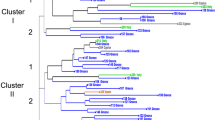Abstract
We studied the genetic diversity of 34 fig varieties (Ficus carica L.) to provide a reference for analyzing the phylogenetic relationships and variety identification of figs. A total of 34 fig materials were amplified by inter-simple sequence repeat (ISSR) molecular marker technique. The products were detected by agarose gel electrophoresis and analyzed by using POPGENE 1.32 and NTSYS 2.10. Nine polymorphic primers were screened from 100 ISSR primers, and 107 loci were amplified, 74 were polymorphic loci, and the polymorphic loci ratio was 69.16%. The number of alleles was observed. The Na average was 1.6729, and the effective allele number (Ne) was 1.4022. The Nei’s gene diversity index (He) was 0.2316. The Shannon information index (I) was 0.3447, and the genetic similarity coefficient (GS) was between 0.6262 and 0.9720 the average values. UPGMA method was used to construct the clustering map. With GS 0.824 as the threshold, 34 fig varieties were divided into eight groups, thus indicating that ISSR molecular markers can be effectively applied to the genetic diversity analysis of different fig varieties.


Similar content being viewed by others
References
Dockter RB, Elzinga DB, Geary B, Maughan PJ, Johnson LA, Tumbleson D, Franke J, Dockter K, Stevens MR (2013) Developing molecular tools and insights into the Penstemon genome using genomic reduction and next-generation sequencing. BMC Genet 14(1):66
Gaughran ERL (1976) Ficin: history and present status. Q J Crude Drug Res 14(1):1–21
Godwin ID, Aitken EA, Smith LW (2010) Application of inter simple sequence repeat (ISSR) markers to plant genetics. Electrophoresis 18(9):1524–1528
Guo ZB, Han BM, Guo Q (2017) Analysis of genetic diversity of 30 fig varieties by SSR fluorescent labeling capillary electrophoresis. J Zhejiang Agric Sci 29(9):1482–1488
Huang BE, George AW, Forrest KL, Kilian A, Hayden MJ, Morell MK, Cavanagh CR (2012) A multiparent advanced generation inter-cross population for genetic analysis in wheat. Plant Biotechnol J 10(7):826–839
Ikegami H, Nogata H, Hirashima K, Awamura M, Nakahara T (2009) Analysis of genetic diversity among European and Asian fig varieties (Ficus carica L) using ISSR, RAPD, and SSR markers. Genet Resour Crop Evol 56(2):201–209
Jiang YH, Zhang LP, Zhou XG, Wang YF (2016) Application of ISSR molecular marker in the genetic relationship of Amaranth. World Sci Technol Mod Tradit Chin Med 18(03):111–115
Kislev ME, Hartmann A, Bar-Yosef O (2006) Early domesticated fig in the Jordan Valley. Science 312(5778):1372–1374
Li LQ, Zhang JG, Ma K (1997) Cultivation and utilization of fig and its development prospects. Sichuan Friut Tree 1:23–24
Lin ZK, Sun WJ, Chen ZD, Lin WD, Xiao S (2014) ISSR molecular marker technology and its application in tea plant research. Guangdong Agric Sci 9:139–142
Liu GS, Zhang YG, Tao R, Fang JG, Dai HY (2014) Identification of apple cultivars on the basis of simple sequence repeat markers. Genet Mol Res 13(3):7377–7387
Lu JS, Bu ZY, Lv WL, Su JM, Huang CY, Li CN (2013) ISSR genetic diversity analysis of dendrobium germplasm resources from different habitats. Chin Tradit Herb Drugs 44(1):96–100
Ma L, Hou LF, Hao ZX (2015) ISSR analysis of genetic diversity of 82 pomegranate varieties. J Fruit Sci 32(5):741–750
Sadder MT, Ateyyeh AF (2006) Molecular assessment of polymorphism among local Jordanian genotypes of the common fig (Ficus carica, L.). Sci Hortic 107(4):347–351
Samal KC, Jena RC, Swain SS, Das BK, Chand PK (2012) Evaluation of genetic diversity among commercial cultivars, hybrids and local mango (Mangifera indica L.) genotypes of India using cumulative RAPD and ISSR markers. Euphytica 185(2):195–213
Shen YY (2018) Current status, problems and countermeasures of fig development in China. Chin Hortic Dig 2:75–78
Sun QX, Chen J, Zhang H, Qi JM, Lin ZP, Hu YL, Lin XJ (2012) Screening of Isveradium yunnanensis ISSR primers and optimization of PCR reaction system. J Plant Genet Resour 13(5):870–878
Sun R, Sun L, Jia M, Yang L, Liu BF, Hao XY (2014) Analysis of nutritional components of Fig varieties introduced in Shandong. Econ For Res 32(4):63–67
Wang XM (2010) Optimization of DNA isolation, ISSR-PCR system and primers screening of genuine species of rhubarb, an important herbal medicine in China. J Med Plants Res 4(10):904–908
Wang J, He Q, Ou Y (2008a) ISSR identification and genetic relationship analysis of plum germplasm resources. J Fruit Sci 25(2):182–187
Wang J, Qiao HE, Yi OU (2008b) Germplasm identification and phylogenetic analysis of plum using ISSR marker. J Fruit Sci 25(2):182–187
Wang L, Wang CH, Tian YZ (2008c) Research progress on fig germplasm resources. Deciduous Fruit Tree 40(5):26–29
Wang MJ, Huang L, Liu KY (2017) Establishment of ISSR molecular marker system and cluster analysis of germplasm resources. J Fruit Sci 3:279–287
Wu ZX, Wang HZ, Shi NN (2008) Genetic diversity analysis of ISSR in cymbidium plants. Genetics 30(5):627–632
Yu Y, Chen HS, Ge XJ (2003) Optimization and screening of primer reaction conditions for simple repeat sequence interval (ISSR). J Trop Subtrop Bot 11(1):15–19
Zhou YX, Zhou W (2011) Application of ISSR molecular marker technology in crop genetics and breeding. J Inner Mongolia Univ Natl Nat Sci Ed 26(6):682–684
Zhu YF, Zhu SJ, Li YP (2010) Application of ISSR molecular marker technology in the study of plant germplasm resources. Seeds 29(2):55–59
Zietkiewicz E, Rafalski A, Labuda D (1994) Genome fingerprinting by simple sequence repeat (SSR)-anchored polymerase Chain reaction amplification. Genomics 20(2):176–183
Funding
This study had no funding support.
Author information
Authors and Affiliations
Corresponding author
Ethics declarations
Conflict of interest
The authors declare that they have no conflict of interest.
Additional information
Publisher's Note
Springer Nature remains neutral with regard to jurisdictional claims in published maps and institutional affiliations.
Rights and permissions
About this article
Cite this article
Zhang, X., Kong, W., Wang, X. et al. Genetic diversity analysis of 34 fig varieties (Ficus carica L.) based on ISSR molecular marker. Genet Resour Crop Evol 67, 913–921 (2020). https://doi.org/10.1007/s10722-020-00889-5
Received:
Accepted:
Published:
Issue Date:
DOI: https://doi.org/10.1007/s10722-020-00889-5




